
views
Choosing a Form for the Poem

Read examples of love poems. To get a better sense of how you can approach your poem for your boyfriend, you may want to read a few examples, such as: “I Loved You First: But Afterwards Your Love...” by Christina Rossetti. “Flirtation” by Rita Dove. “I Love You” by Ella Wheeler Wilcox. "Having a Coke with You" by Frank O'Hara.

Examine the examples. Look at how each example addresses a romantic relationship and love. Compare and contrast the examples to determine which ones you may prefer or feel will fit best with your subject matter. Ask yourself, How does the author approach love and what being in love means to them? Do they use imagery, description, and detail to illuminate their sense of love and romance? What type of form does the writer chose for the poem and how does this contribute to the poem overall?

Try the free verse form. One of the more popular forms in poetry is free verse. This form is easy to learn and can be freeing, especially if you are new to writing poetry. Free verse has no set meter, structure, or rhyme scheme. But a free verse poem should still feel cohesive and express its ideas clearly. In the free verse form, you can play around with the length of each line and the descriptions and images you insert in the poem. For example, the poem “Flirtation” by Rita Dove uses two line stanzas and breaks up the text so one stanza flows into another. She uses the free verse form to show how flirtation happens in small, short bursts, much like blocks of text broken up on the page. In contemporary poetry, free form and free verse poems seem to be the most popular right now.
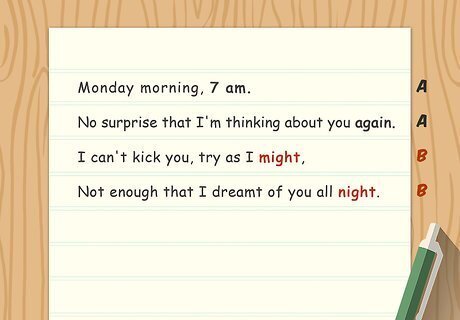
Go for a rhyming form. Another popular form for romance poetry is to use rhyming or a rhyming form. Many traditional and modern love poems are written with rhyme. There are several popular rhyming forms you may want to try for your poem, including: An alternate rhyme: Often, this rhyme follows the pattern ABAB, where the first and third line rhyme (A) and the second and fourth line rhyme (B). This rhyming pattern may then be repeated in each stanza or section of the poem. Rhyming couplet: This form has two line stanzas that rhyme and may be placed in pairs or added at the end of a stanza. The rhyme scheme could be “A,A,B,B,C,C,...” Ballade: This form has three stanzas with a rhyme scheme of “ABABBBCBC”, followed by “BCBC”. Feel free to use internal rhymes, too—not all rhyming poetry needs to end on a rhyme. Use rhymezone.com to find plenty of rhyming words. Just type in the word that you want to use, and see what other rhyming words it brings up. The site also suggests near rhymes, or words that sound similar without actually rhyming.
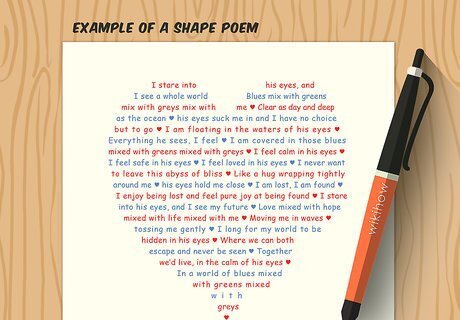
Choose a more visual form. You may want to make the poem feel more personal by using images of you and your boyfriend in the text of the poem or at the beginning or end of the poem. You could also break up the text so it looks visually interesting on the page, similar to Rita Dove’s approach in “Flirtation”. Another simple visual form is to make an acrostic poem, where a row of vertical letters going down the page spell out a word, phrase, or maybe your boyfriend’s name. You would then use each letter as the first letter of a line or phrase in the poem.
Brainstorming Ideas and Content for the Poem
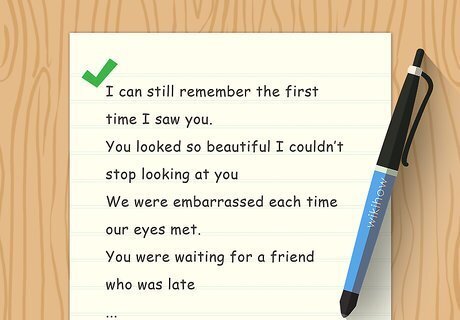
Write about how you and your boyfriend met. You may want to go back to the beginning of your relationship and discuss how you met your boyfriend. Was it love at first sight or was your first meeting disappointing? Did you meet each other through friends or through funny circumstances? What kind of emotions did you feel when you met your boyfriend? Write down as much as you can remember about your first meeting. Maybe you can more easily recall your first date with him or your first kiss. You may decide to focus on the details of these other firsts. Using a first meeting or first kiss memory in the poem will make it feel more personal and specific to the two of you.
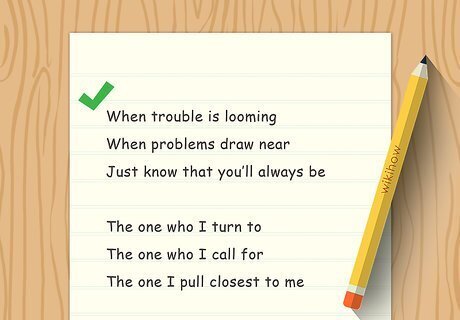
Describe how and why your boyfriend is important to you. You can also come up with themes and ideas for the poem by writing down the ways in which your boyfriend is important to you. Doing this will help you create a poem that feels like a tribute to your boyfriend and your love for each other. You may focus on his excellent personal qualities and traits, such as “good listener”, “kind heart”, “supportive”, or “generous”. You may also consider why you value these traits about him. Maybe you appreciate his ability to listen because you find it difficult to listen to others and you admire his genuine interest in people. Or, maybe you valued his support at a particular time because you needed him and he was there for you.
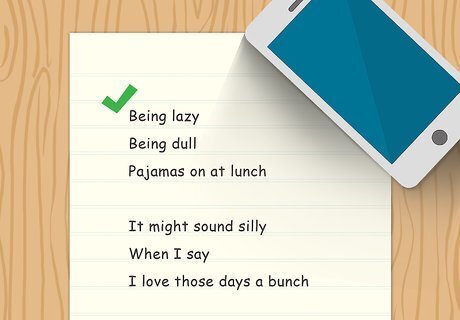
Recall a fond memory you have with your boyfriend. This could be the first time you traveled together to a foreign country or a blissful day on vacation together. You may also focus on a memory that is positive because of something your boyfriend did, such as helping you deal with the death of a parent or supporting you as you prepared for a difficult exam or test. Be specific when you describe this memory. Focus on sensory detail, such as what you both were wearing in this memory, where the memory occurred, and any smells or sounds in the setting of the memory. You should also try to describe facial expressions and body language, such as your boyfriend’s smile or your laugh.

Write about any challenges or issues you both overcame together. Another way to generate ideas for your poem is to think about any hard or challenging times you experienced with your boyfriend. No relationship is perfect and you both have likely had ups and downs during your time together. You can spotlight any challenges and use them as examples of how your love persevered and got stronger due to these challenges. You may focus on one specific memory where you made a mistake or your boyfriend made a mistake and you both worked through it together. Or, you may talk about having to maintain love from a distance or away from your boyfriend and how you made it work. The idea is to highlight a memory that shows how strong and powerful your love is, and how much stronger it is going to be in the future.
Creating the Poem
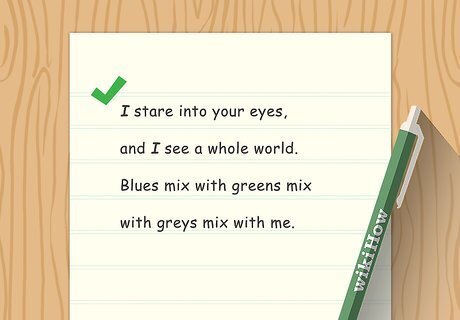
Write in the first person. Because this is a personal poem for your boyfriend, you should focus on writing from your voice and your perspective. This means using “I” or first person, to discuss your feelings and emotions towards your boyfriend. The poem should reflect your personality and your personal thoughts on your boyfriend. Using your natural voice and style will help it feel unique to you.
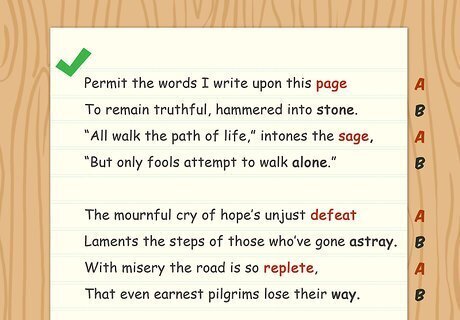
Stick to your form. If you have a selected a specific form for your poem, such as free verse or a rhyming form, you should commit to it and follow the structure of the form. Read other examples of the form and try to follow their lead. Following a consistent pattern can make your poem feel cohesive and like a real piece of art. If you want to use a rhyming scheme, try to choose one that does not use a lot of rhyming. Too much rhyming can sound sing-songy and make your poem sound a little cheesy or silly. Ella Wheeler Wilcox’s poem “I Love You” is a good example of using rhyme to create a romantic poem that does not feel cheesy or overdone.
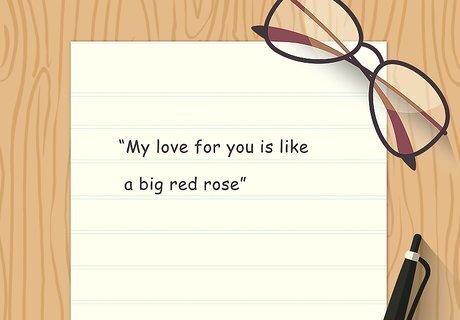
Use simile and metaphor. You should include literary devices like simile and metaphor in the poem to describe your thoughts and emotions more effectively. Simile uses “like” or "as" to describe something, such as, “My love for you is like a big red rose" or "My love for you is as beautiful as a big red rose.” Metaphor uses direct comparison to describe something, with no "like" or "as" such as “My love for you is a slice of cake." In general, metaphors as used more often in poetry than similes. Try to come up with unique similes and metaphors, as this will make your poem sound more unique and specific to you. Rather than say, “your love is like the wind”, for example, you may choose a more specific metaphor like, “your love is like my favorite food”.
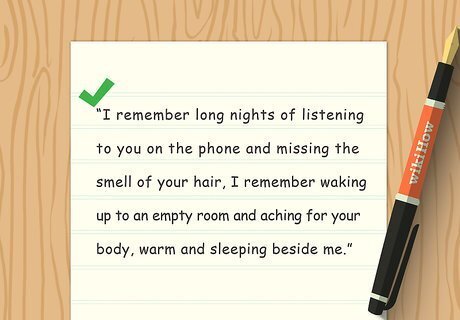
Include sensory details. If you decide to include specific memories in the poem, you should include details that use the five senses (sound, sight, taste, touch, and smell). Using sensory details will make your memories come alive and give your reader a better sense of the memory. For example, rather than describe being away from your boyfriend during a hard time as “full of loneliness and sadness”, you could delve into a specific memory of loneliness or sadness during that time. You may say, “I remember long nights of listening to you on the phone and missing the smell of your hair, I remember waking up to an empty room and aching for your body, warm and sleeping beside me.”

Replace cliches with unique descriptions and phrases. To make your poem that much stronger, you should avoid using cliches and familiar terms or phrases. Instead, push yourself to come up with unfamiliar or unique descriptions. A good rule of thumb with cliches is that if the phrase sounds familiar to you and you think you have heard it before, it is likely a cliche. There are many cliches around the theme of love and relationships, from “roses are red” to “dreaming of you” to “you make my heart swoon”. Try to replace these familiar descriptions with ones that are specific to you and your boyfriend. For example, if you and your boyfriend love pizza, maybe you could try to use as many pizza related descriptions as possible, from “your love is as essential as my favorite pepperoni pizza” to “I love you more than Ranch dipping sauce”.

Recite the poem out loud to yourself. After you have created your poem, you should read it out loud to yourself to hear how the words sound together in each line. Check for any lines that sound awkward or not quite right. Mark any words that seem too vague or unclear. Make sure your poem includes specific detail and sensory descriptions so it feels descriptive and engaging. As you read, you may want to mark up the poem and note any awkward lines or words. You can then edit the poem for clarity and tone, focusing on the sections you have marked.

Give your boyfriend the poem once it is done. Surprise your boyfriend by writing the poem in a nice card or printing it out and leaving it for him on his pillow to find in the morning. Make the poem feel like a special gift for him to discover and make the decorations personal so he knows how much you care for him.


















Comments
0 comment